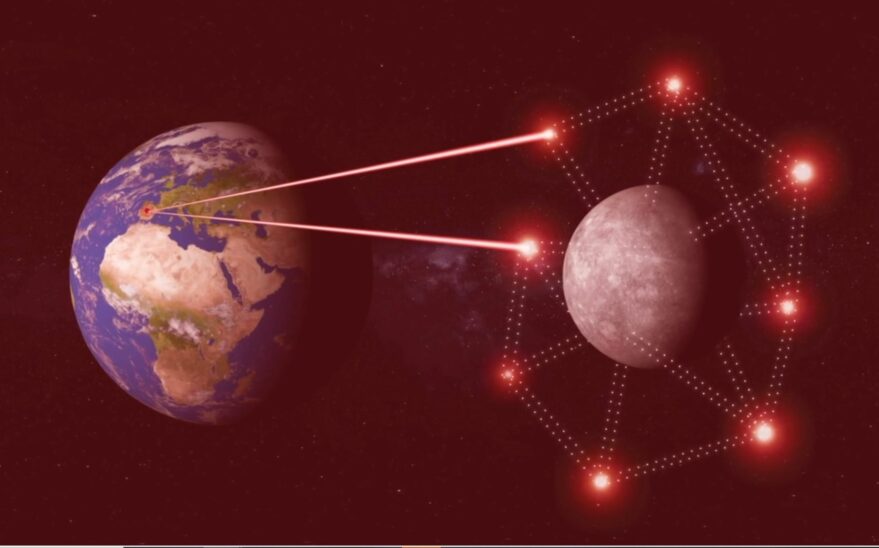TAMPA, Fla. — Spanish-German startup Plus Ultra Space Outposts plans to deploy the bulk of its proposed lunar communications and navigation constellation with ispace, the Japanese lunar transportation venture selling accommodations on its moon-bound landers.
Plus Ultra and ispace announced a collaboration agreement Jan. 20 that includes the transport and deployment of Plus Ultra’s Harmony minisatellites as soon as 2024.
Tokyo-based ispace aims to become the first privately-led Japanese mission to perform a soft landing on the moon when its robotic Series 1 lander launches on a SpaceX Falcon 9 later this year.
Plus Ultra expects to launch its first satellite in late 2023 with German startup Rocket Factory Augsburg before hitching its first ride with ispace as part of the venture’s third lander mission.
That mission would mark the debut of the larger Series 2 lander that ispace unveiled in August during the 36th Space Symposium in Colorado Springs, Colorado.

According to ispace, its Series 2 lander will be capable of carrying 2,000 kilograms of payload to lunar orbit and 500 kilograms to the moon’s surface — significantly more than the 30 kilograms the first two Series 1 landers will be able to tote.
The Series 2 lander will be equipped with enough onboard propulsion to reach the moon on its own after separating from the rocket that launches it into space. The Series 2 lander is being designed and built in the United States to compete for contracts under NASA’s Commercial Lunar Payload Services program.
Mission operation details are not being disclosed. However, the Series 2 lander’s 2,000 kilograms of carrying capacity to lunar orbit means that a single mission could potentially deploy more than one of the eight 400-kilogram satellites that Plus Ultra plans to send to the moon to provide communications and navigation services for visiting spacecraft.
Plus Ultra’s Harmony constellation would support ispace operations, among other collaborations that have yet to be defined in return for transport to the moon.
Carlos Utrilla, Plus Ultra’s founder and CEO, told SpaceNews that the startup is in the middle of a 5.5 million euro ($6.2 million) early-stage funding round. It needs to close the round before picking a manufacturer for the satellites.
Japan’s ispace had raised $200 million as of late October, including an investment from Airbus Ventures.
Julien-Alexandre Lamamy, managing director of ispace’s European division that signed the collaboration agreement with Plus Ultra, said in the same interview that SpaceX is on track to launch the company’s first lander as a secondary payload in the second half of this year. The second mission for ispace’s Series 1 lander is slated for 2023, also aboard a SpaceX Falcon 9 rocket.

Plus Ultra plans to launch its first Harmony satellite in the final quarter of 2023 with Rocket Factory Augsburg under an agreement signed in October. The first flight of the German startup’s RFA One, a three-stage rocket designed to lift 450 kilograms to geostationary transfer orbit (GTO), is slated for later this year.
Utrilla said Plus Ultra’s first 400-kilogram Harmony satellite would need six to eight months to reach the moon via onboard electric propulsion after separating from RFA One’s in GTO.
Booking passage for subsequent Harmony satellites on ispace lander missions, Utrilla said, would accelerate the constellation’s deployment and expose Plus Ultra satellites to less radiation as they travel through the Van Allen belts better protected by the lander’s multi-layer insulation.
The executives declined to disclose how long it will take ispace Series 2 landers to reach lunar orbit following launch.
With the first Harmony satellite not expected to make it to the moon until sometime in 2024, ispace’s first two missions rely on the European Space Agency’s Earth-based Estrack ground station network to communicate with its Series 1 landers.
“Right now, our lander has to land on the near side of the moon in order to have visibility to the ground stations on the Estrack network,” Lamamy said.
“To land on the far side, we need relay satellites.”
According to Utrilla, the full Harmony constellation will provide continuous high-speed communications of up to 100 megabits per second (Mbps) between any location on or around the moon, including the far side and the poles, and anywhere on Earth.
Harmony’s navigation services, he said, would be accurate to within a 20 meter or smaller radius. A typical GPS-enabled smartphone is accurate to within 5 meters under an open sky.
